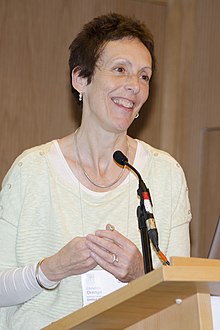Christine Orengo
Christine Orengo | |
|---|---|
 | |
| Born | Christine Anne Orengo 22 June 1955[6] |
| Alma mater |
|
| Known for | |
| Awards |
|
| Scientific career | |
| Fields | |
| Institutions | |
| Thesis | A study of the redox properties of haem in proteins and model systems (1984) |
| Doctoral students | |
| Website | |
Christine Anne Orengo is a Professor of Bioinformatics at University College London (UCL)[2][8][9] known for her work on protein structure, particularly the CATH database.[7][10]
Education
Orengo studied Chemical Physics at the University of Bristol where she was awarded a Bachelor of Science degree.[when?] She continued her studies at the University of Aberdeen where she was awarded a Master of Science degree in Medical Physics in 1977 for research on the disruption of iron metabolism in laboratory rats with Yoshida sarcomas.[11] She was awarded a PhD for research on the redox properties of haem in proteins in 1984 from UCL.[12]
Career
Following her PhD, Orengo worked in industry[when?][where?] before being appointed a postdoctoral researcher at the National Institute for Medical Research (NIMR) in Mill Hill where she worked until 1990.[10] She joined the Department of Biochemistry and Molecular Biology at UCL and in 1995 and was awarded a Medical Research Council (MRC) Senior Fellowship in Bioinformatics. She was promoted to Professor of Bioinformatics in 2002.[10]
Research
Orengo's research analyses genes, proteins and biological systems using computational methods to classify proteins into evolutionary families. This work has been funded by the Medical Research Council (MRC) and the Biotechnology and Biological Sciences Research Council (BBSRC).[13]
Orengo is co-editor with David Jones and Janet Thornton of the textbook Bioinformatics: Genes, Proteins and Computers.[14] As of 2015[update], according to Google Scholar[2] and Scopus[8] her most cited work has been published in Nature,[15] Nucleic Acids Research,[16][17] Structure[7] and the Journal of Molecular Biology.[18][19]
Awards and honours
Orengo was elected a member of the European Molecular Biology Organization (EMBO) in 2014.[1][20]
References
- ^ a b "The EMBO Pocket Directory" (PDF). Heidelberg: European Molecular Biology Organization. Archived from the original (PDF) on 2015-03-16.
- ^ a b c Christine Orengo publications indexed by Google Scholar
- ^ Lehtinen, Sonja; Bähler, Jürg; Orengo, Christine (2015). "Co-Expression Network Models Suggest that Stress Increases Tolerance to Mutations". Scientific Reports. 5: 16726. doi:10.1038/srep16726. ISSN 2045-2322. PMC 4644955. PMID 26568486.

- ^ "Orengo lab alumni". University College London. 2015-05-22. Archived from the original on 2015-05-22.
- ^ Sillitoe, Ian. (2003). Consensus templates for protein structure recognition (PhD thesis). University College London. OCLC 500146824.
- ^ Christine Orengo at Library of Congress
- ^ a b c Orengo, C. A.; Michie, A. D.; Jones, S.; Jones, D. T.; Swindells, M. B.; Thornton, J. M. (1997). "CATH – a hierarchic classification of protein domain structures". Structure. 5 (8): 1093–1109. doi:10.1016/S0969-2126(97)00260-8. PMID 9309224.
- ^ a b Christine Orengo's publications indexed by the Scopus bibliographic database. (subscription required)
- ^ Christine Orengo's ORCID 0000-0002-7141-8936
- ^ a b c "Professor Christine Orengo". University College London. Archived from the original on 2015-05-19.
- ^ Orengo, Christine Anne (1977). Disruption of iron metabolism in rats with Yoshida sarcomas (MSc thesis). University of Aberdeen. OCLC 646442339.
- ^ Orengo, Christine Anne (1984). A study of the redox properties of haem in proteins and model systems (PhD thesis). University College London. OCLC 927065626.
- ^ "UK Government research grants awarded to Christine Orengo". Research Councils UK. 2015-11-27. Archived from the original on 2015-11-27.
- ^ Bioinformatics: Genes, Proteins and Computers. BIOS. 2003. ISBN 1859960545.
- ^ Orengo, Christine Anne; Jones, David T.; Thornton, Janet M. (1994). "Protein superfamilles and domain superfolds". Nature. 372 (6507): 631–634. doi:10.1038/372631a0. ISSN 0028-0836.
- ^ Hunter, S.; Apweiler, R.; Attwood, T.; Bairoch, A.; Bateman, A.; Binns, D.; Bork, P.; Das, U.; Daugherty, L.; Duquenne, L.; Finn, R. D.; Gough, J.; Haft, D.; Hulo, N.; Kahn, D.; Kelly, E.; Laugraud, A.; Letunic, I.; Lonsdale, D.; Lopez, R.; Madera, M.; Maslen, J.; McAnulla, C.; McDowall, J.; Mistry, J.; Mitchell, A.; Mulder, N.; Natale, D.; Orengo, C.; Quinn, A. F. (Jan 2009). "InterPro: the integrative protein signature database". Nucleic Acids Research. 37 (Database issue): D211–D215. doi:10.1093/nar/gkn785. ISSN 0305-1048. PMC 2686546. PMID 18940856.

- ^ Hunter, S.; Jones, P.; Mitchell, A.; Apweiler, R.; Attwood, T. K.; Bateman, A.; Bernard, T.; Binns, D.; Bork, P.; Burge, S.; De Castro, E.; Coggill, P.; Corbett, M.; Das, U.; Daugherty, L.; Duquenne, L.; Finn, R. D.; Fraser, M.; Gough, J.; Haft, D.; Hulo, N.; Kahn, D.; Kelly, E.; Letunic, I.; Lonsdale, D.; Lopez, R.; Madera, M.; Maslen, J.; McAnulla, C.; McDowall, J. (2011). "InterPro in 2011: New developments in the family and domain prediction database". Nucleic Acids Research. 40 (Database issue): D306–D312. doi:10.1093/nar/gkr948. PMC 3245097. PMID 22096229.
- ^ Todd, Annabel E; Orengo, Christine A; Thornton, Janet M (2001). "Evolution of function in protein superfamilies, from a structural perspective". Journal of Molecular Biology. 307 (4): 1113–1143. doi:10.1006/jmbi.2001.4513. ISSN 0022-2836. PMID 11286560.
- ^ Taylor, William R.; Orengo, Christine Anne (1989). "Protein structure alignment". Journal of Molecular Biology. 208 (1): 1–22. doi:10.1016/0022-2836(89)90084-3. ISSN 0022-2836. PMID 2769748.
- ^ "EMBO member: Christine Anne Orengo". Heidelberg: EMBO. Archived from the original on 2015-12-06.
